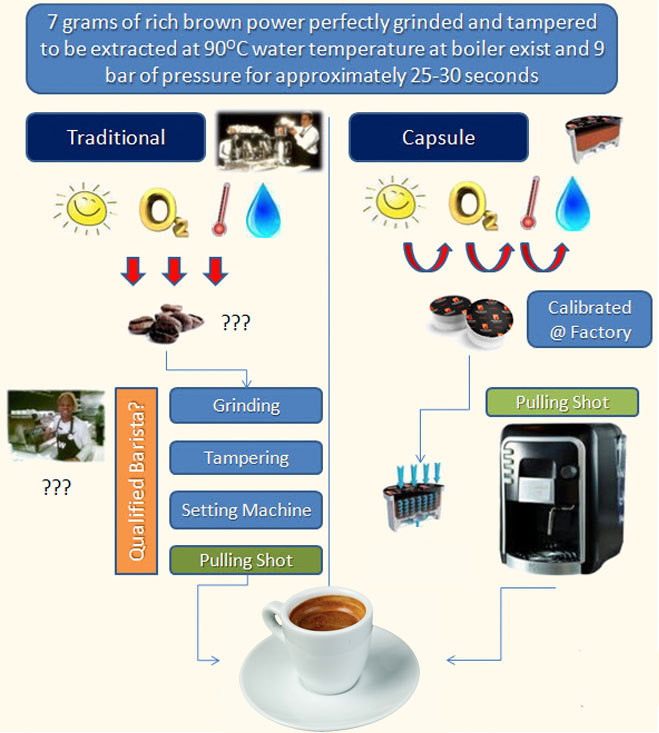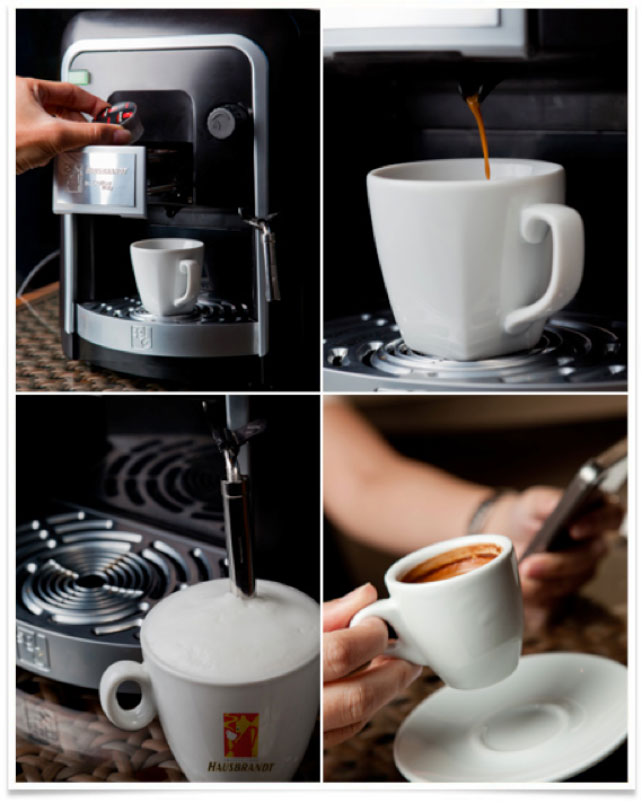

ทำความรู้จักกับกาแฟช็อทกันเถอะ
เพื่อให้คุณได้ดื่มด่ำกับประสบการณ์ของกาแฟอิตาเลี่ยนเราได้จัดทำสูตรทำกาแฟต่างๆโดยใช้เครื่องทำกาแฟ ฮาวส์บรันท์ แคปซี่ (Hausbrandt Capsy) แล้วคุณก็จะสามารถทำกาแฟให้คุณและคนที่คุณรักที่แสนอร่อยและเพอร์เฟคได้ในทุกๆแก้วได้ที่บ้านของคุณ
เพื่อให้คุณได้ดื่มด่ำกับประสบการณ์ของกาแฟอิตาเลี่ยนเราได้จัดทำสูตรทำกาแฟต่างๆโดยใช้เครื่องทำกาแฟ ฮาวส์บรันท์ แคปซี่ (Hausbrandt Capsy) แล้วคุณก็จะสามารถทำกาแฟให้คุณและคนที่คุณรักที่แสนอร่อยและเพอร์เฟคได้ในทุกๆแก้วได้ที่บ้านของคุณ
กาแฟแคปซูลดีอย่างไร?
การเปลี่ยนจากกาแฟปกตินั้น มาเป็นกาแฟแคปซูลมีข้อดีอย่างไร แตกต่างกันอย่างไร เรามาดูกันค่ะ

ระบบกาแฟแคปซูลดีอย่างไรสำหรับร้านค้า?
มาดูกันค่ะว่าสำหรับทางบ้าน หรือร้านค้าที่นำเครื่องทำกาแฟ Hausbrandt by Coffee Italy ไปใช้นั้นจะมีส่วนช่วยอะไรได้บ้าง
ลดเวลา
ช่วยประหยัดเวลาในการเตรียมกาแฟการเก็บทำความสะอาดและการดูแลรักษาได้
สามารถเพิ่มกำไรให้ร้านค้า
การมีกาแฟที่หลากหลายสามารถตอบสนองต่อควมต้องการของลูกค้าได้มาก อีกทั้งยังเป็นกาแฟที่ม่ีคุณภาพสามารถขายแก่ลูกค้าในราคาที่สูงขึ้น
ประหยัด
เครื่องทำกาแฟนี้บังช่วยลดของเสียที่เกิดจากความผิดพลาดต่างๆ อีกทั้งยังใช้พื้นที่ในการติดตั้งน้อย

ทำไมต้องเป็น Hausbrandt?
ขั้นตอนการคัดเมล็ดกาแฟ Hausbrandt ซื้อโดยตรงจากผู้ผลิตในลาตินอเมริกาและแอฟริกาโดยมีการขอตัวอย่างสินค้าเพื่อทำการตรวจสอบในห้องแลบก่อนที่จะทำการสั่งชื้อจากแหล่งผลิต และมีการตรวจสอบอีกครั้งเมื่อสินค้ามาถึง...

ขั้นตอนการคัดเมล็ดกาแฟ Hausbrandt ซื้อโดยตรงจากผู้ผลิตในลาตินอเมริกาและแอฟริกาโดยมีการขอตัวอย่างสินค้าเพื่อทำการตรวจสอบในห้องแลบก่อนที่จะทำการสั่งชื้อจากแหล่งผลิต และมีการตรวจสอบอีกครั้งเมื่อสินค้ามาถึง
ขั้นตอนการคั่ว Hausbrandt ได้นำเทคโนโลยีการคัดเมล็ดที่ไม่สุก เสีย หรือสุกเกินไปออกแบบ 100% ก่อนขบวนการคั่ว
การคั่วเป็นแบบช้า (slow roasting) และมอนิเตอร์อุณหภูมิด้วยคอมพิวเตอร์ หลังจากนั้นเป็นการทำให้เย็นเพื่อล็อคคุณสมบัติและรสชาดไว้
ขั้นตอนต่อไปคือการพักในถังพักตามระยะเวลาของแต่ละสูตร ก่อนนำไปบรรจุในบรรจุภัณฑ์ในสภาพแวดล้อมที่เป็นสูญญากาศเพื่อรักษาสภาพของสินค้าไว้
ทุกขั้นตอนจะถูกควบคุมโดย Master Roaster Mr. Giancarlo Biasotto

ทำไมกาแฟจากอิตาลีจึงมีความแตกต่าง?
การดื่มกาแฟ เป็นส่วนหนึ่งของวัฒนธรรมของอิตาลีซึ่ง คนอิตาเลี่ยนจะมีความภาคภูมิใจมากในกาแฟของเขามากและบริษัทคั่วกาแฟจะมีความใส่ใจในรายละเอียดเรื่องของคุณภาพมาก...

การดื่มกาแฟ เป็นส่วนหนึ่งของวัฒนธรรมของอิตาลีซึ่ง คนอิตาเลี่ยนจะมีความภาคภูมิใจมากในกาแฟของเขามากและบริษัทคั่วกาแฟจะมีความใส่ใจในรายละเอียดเรื่องของคุณภาพมาก
How Hausbrandt gets its coffee beans
Although there are over 60 species of coffee in the world, the berries used to prepare the beverage come from only two species: Coffea arabica, approximately 75%, and Coffea robusta, 25%. Arabica Despite the name, this variety of coffee plant originated in Ethiopia and represents 75% of the world coffee production. Currently, Brazil is the largest Arabica coffee producer in the world, followed by several other Latin American countries. Robusta As with the Arabica variety, Robusta pla
The Species
Although there are over 60 species of coffee in the world, the berries used to prepare the beverage come from only two species: Coffea arabica, approximately 75%, and Coffea robusta, 25%.
Arabica
Despite the name, this variety of coffee plant originated in Ethiopia and represents 75% of the world coffee production. Currently, Brazil is the largest Arabica coffee producer in the world, followed by several other Latin American countries.
The beans have a typical green-blue and yellow-green colour and an elongated shape.
Regarding the taste and aroma, Arabica produces an aromatic, sweet and delicate coffee and is characterized by a low caffeine content, between 0.8 and 1.5%.
Robusta
As with the Arabica variety, Robusta plants prefer the equatorial zones of the planet and trace their origins to Central Africa. Currently, this variety is primarily cultivated in tropical Asiatic regions, Vietnam in particular, as well as tropical African regions and Brazil. More productive, hardier and quicker to ripen, Robusta plants produce roundish beans that are yellow or yellow-brown in colour. Compared to Arabica, this variety produces a coffee that is more full-bodied, bitter and has a caffeine content that varies between 1.7 and 3.5%.
The Plants
The coffee plant is an evergreen shrub belonging to the Rubiaceae family of the genus Coffea, with shiny, dark-green, pointed leaves and white blossoms that have an intense perfume reminiscent of jasmine. The green, cherry-shaped fruit turn red when they have fully ripened. There are two beans inside every drupe; these are flat on the interior side where the beans touch, have a groove and convex exteriors. In some cases, when the fruit grows at the end of the branch, only a single round bean, called a peaberry or caracoli, develops inside the drupe.
The Harvest
There are two harvesting methods: picking and stripping. The first method, which is completely manual, consists of harvesting only the red, and therefore completely ripe, cherries from the coffee plant. This method is very expensive, of course, but it guarantees a decidedly high average quality for the product. Stripping, on the other hand, consists of a much faster process in which entire clusters of ripened berries are removed, either by hand or with appropriate machinery.
On the ground, the beans are collected and placed in baskets; however, there is a higher risk of also gathering unripe or overripe beans than in the picking method.
Once harvested, the beans are separated from the pulp, using either the dry method or the wet method. The dry method is the process used to obtain "natural" coffees and consists of drying the cherries in the sun for several days. After the required amount of time for complete drying has passed, the drupes are pulped with appropriate machinery, removing the skin and the dry pulp.
The wet method, which is lengthier and more costly, produces what is known as "washed" coffee. However, this system requires the availability of the large quantities of water needed to wet the sieves through which the fruit passes to remove the pulp. After passing through these sieves, the beans are placed in fermentation tanks. When the fermentation process is complete, the beans are washed and then dried either mechanically or in the sun. Once dry, the beans are milled to remove the parchment and reveal the green coffee bean.
The selection process
As the quality of the coffee is the primary feature that distinguishes Hausbrandt, the company has adopted a rigorous inspection and quality control system. The company has many mechanisms in place, including bi-chromatic sorting, to guarantee the highest level of quality.
Over a distance of just 10 cm, every single Arabica bean is analyzed 30 times by photocells that can recognize and remove unripe, tough or fermented beans that could compromise the quality of the final product. This is followed by the washing, polishing, and selecting of the Robusta beans; these steps eliminate foreign flavours, toughness and taste defects that could alter the characteristics of the coffee's body.
Hausbrandt technicians constantly monitor every single step of the selection process so that only the very best coffee beans, in excellent condition, go on to be roasted.


